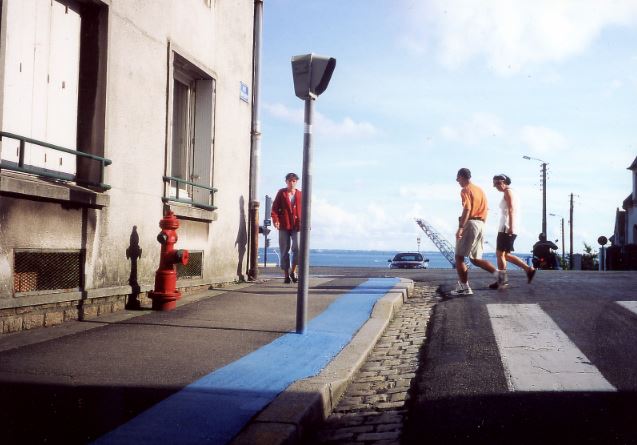Gwenaëlle Magadur, The Blue Line, Brest, 2000.
This ephemeral installation was created by Brest artist Gwenaëlle Magadur with the support of Brest city council, Finistère county council and Brittany’s regional council. The Blue Line marked ‘the great belt’ of the city walls of Brest, designed by Vauban in the 17th century. These walls were demolished after the Second World War in the rush to rebuildand allow the city to expand.
For several decades, this “Brest of which nothing remains” (to quote Jacques Prévert) had been all but forgotten by its inhabitants. Gwenaëlle Magadur, seeking to uncover traces of this urban past shrouded in silence, made a proposition to the council. The idea was to mark the placement of the old ramparts with an ephemeral blue line. Compared to other artistic commissions, this one was different in that it was, above all, personal research and a private initiative.
The Blue Line came into being in the year 2000, prompting questions from locals, who were initially ill-informed about the meaning of this atypical road marking. Designed with a “skin like” texture, the line, which eroded bit by bit due to the footfall of passers-by, gradually faded away (albeit more slowly than expected). Nevertheless, it raised a general awareness of the potential of Brest’s historical imagination. This appreciation of Brest’s past was rekindled by the maritime festivals which gave the public access to the banks of the Penfeld, a military territory. It was following this experience that the artist came up with the ideaof the Blue Line, the ephemeral work that is now also part of the imagination of Brest – a palimpsest city.
A few years later, Gwenaëlle Magadur worked on a joint project with the architect Sylvain Le Stum on remembering Recouvrance and the banks of the Penfeld. This artistic residency gave rise to the work ‘La ville en mutation’ (The changing city), which was made up of photomontages (installation proposals) in which destroyed plots of land from this working-class district and the sunken facades of old city buildings buried under the rubble of rebuilt Brest reappear.
Sonia de Puineuf

